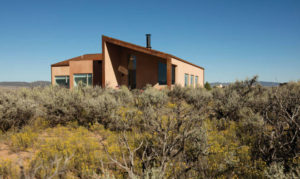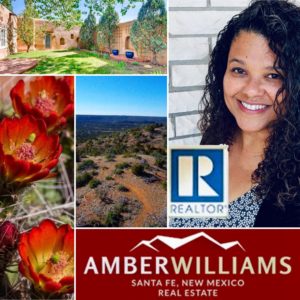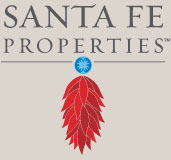Above: Rodin’s house has angular lines that marry traditional and urban materials.
THE FIRST ROOM Lois Rodin wants to show me in her Taos home is the art studio. She has laid out a welcoming homemade blueberry pie on an enormous granite-topped kitchen island, but there’s no time to stop for a nibble now. The studio tempts Rodin far more, and she grabs my arm to lead me there.
“This is the first studio I’ve ever had,” she says, pointing out the huge sink and drying racks needed for her work as a silk-screen printmaker. “I love it. I work all the time.” When I ask if she shows in a gallery, Rodin is crisp: “Not showing. Just creating.”
Well, she’s earned it. Rodin had no time for her art during a 26-year career as an arts administrator and studio manager for renowned artist and sculptor Larry Bell, who lives part-time in Taos and currently has work on exhibit in Zürich, Boston, and San Francisco. When Rodin retired and starting building her dream house at the age of 71, it was time to let her own creativity shine—not only in her studio, but in the gorgeous contemporary-style home she helped design for five acres of land near the Río Grande Gorge.
The clean angles and planes of the 2,500-square-foot house rise up out of the wild sagebrush, an unusual look for a Taos house but somehow utterly harmonious with the land. Some walls seem to present more glass than stucco, blurring the definition between indoor and outdoor. Inside, it has the feel of a comfortable art gallery, from the all-white walls and carefully chosen lighting angled to bounce off the walls (“I learned to do that at Larry Bell exhibitions,” says Rodin) to the hallway shelves designed to display her mother’s folk art collection. Larry Bell sculptures and deep orange and red fabrics create graphic accents through the rooms.
“So much of this house is art-based,” says Rodin’s architect, Molly Bell (no relation to Larry). “And there’s a beauty to nature that we’ve framed through the windows.”
While the house is contemporary and open, with few traditional New Mexico motifs, Bell says that it “pulls in some of the local language, but modernizes it.” Consider the rusted square-tubular steel canales, the adobe-colored stucco, and the compound effect of multiple spaces with different roofs, all surrounding a courtyard. The house has three rain-shedding roofs and two flat roofs forming the angular silhouette. “It basically comes from the pueblo,” Bell says, referring to the thousand-year-old multi-apartment structures at nearby Taos Pueblo. “We’re creating these overlapping shapes that form corners and planes.”
It’s touching to see the close relationship between Bell, who was 27 years old when Rodin commissioned her to design this, the young architect’s first home project, and Rodin, a retiree at the end of one career, now starting a “second act.” “I lost a lot of sleep over this house,” Bell says, laughing. “I had complete confidence in her,” Rodin says.
“I sent three different iterations of what I thought she meant, and she said no to every one,” says Bell. But once Rodin prepared cardboard cutouts illustrating how she wanted the spaces in her house to flow, everything clicked. Still, there were moments when Bell had to push Rodin a little, for example with the siding of oxidized steel, a material Rodin thought was more suited to the roof.
“Several times she told me an idea and it took me a couple of days to embrace it,” Rodin says. “I’m surprised by that now.”
The house took eight months to build. The biggest setback came when a bathroom pipe burst and flooded into other rooms, ruining the radiant-heat maple floors (which, fortunately, were insured).
Among the most important requests from Rodin was that the house be designed for her to stay there for a good, long while—“aging in place” is the term that advocates for older people use. “Everything we did was future-oriented,” Bell says, from the single level with no steps to a wheelchair-accessible bathroom and lever hardware on all of the doors. Rodin declares herself lucky to live here. “When I moved in, I felt I was in someone else’s vacation house.” After two years, she is firmly settled in the place she’s named the Mollhaus, in tribute to Molly Bell.
“I sit here every night and watch the mountains turning red,” Rodin says, gesturing toward Taos Mountain. “I like big, open spaces with big views.” So she chooses not to erect fences. That way, she says, “your land blends into the next person’s land, and it’s all mine, as far as I can see.”











